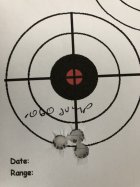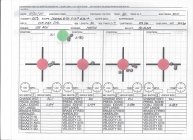I don't think there's just one way to develop a load any more than there is just one style of shooting. So I am curious to see how various people here do their load testing, how they plan on shooting the final loads, how many rounds they shoot when testing etc. My methods have changed a lot over the years and will continue to evolve. For example now the chrono only get used during the first step, after that I rely strictly on what the target tells me. Five years ago I chronoed every single test shot
here is my current method, like I said it is fluid and I like to experiment and change things on occasion. On the load I am working on at the moment I will trying Erik Cortina's seating depth method that was posted in this thread
Since my shooting is done at paper targets currently mostly just F class at 300 to 800 yards and my goal is 1 MOA accuracy of 20 round groups at 800 to be sufficient. I may shoot out to 1000 on occasion so I do like the round to stay supersonic to 1000 if practical. I have to drive 4 hours each way to test at 1000 so that will not be happening. I prefer to do my testing in as low as possible wind conditions and on cloudy days as to minimize the wind and mirage effects. Practice in the worst conditions and test in best conditions is my goal. Over time my testing has changed and evolved and may change in the future again.
With a hypothetical charge range of 42.0 to 44.0 grains I first do a pressure check across the entire range doing jumps of .05 at the low end and .02 at the high shooting one or two rounds at each step. In this hypothetical test that would be something like 42.0, 42.5, 43.0, 43.5, 43.7, 43.9 44.0 for a total of 7 - 10 rounds checking for pressure signs with the primer and for hard bolt lift. These would be shot across a chrono to get a rough indication of speed at 100 yards. I use a seating depth of .025.
After looking at those chrono numbers I know what my minimum charge needs to be so I then load up three or five rounds each from minimum to maximum charge and shot at 100 yards again. For these I am looking at grouping and shot patterns. I figure if three to five rounds do not shoot well, twenty five would shoot bad also.
After that I move out to 300 for further testing of the most promising loads shooting 15 rounds each and looking for a .3 to .5 grain range where the points of impact range overlap.I prefer a load that gives me a minimum of .1 spread on either side that has a similar POI to allow for temp and loading variations.
Finally I do a 20 round test at 600 to check grouping patterns and vertical spread. If the load is borderline on my expectations I may tweak seating depth to see if I can tune the shot pattern
here is my current method, like I said it is fluid and I like to experiment and change things on occasion. On the load I am working on at the moment I will trying Erik Cortina's seating depth method that was posted in this thread
A little Sunday morning reading.
I’m guessing the world is not flat guys ran into some serious issues back in the day. I think this might rank right up there. Very interesting. https://precisionrifleblog.com/2020/04/28/bullet-jump-research-and-load-development-tips/
forum.accurateshooter.com
Since my shooting is done at paper targets currently mostly just F class at 300 to 800 yards and my goal is 1 MOA accuracy of 20 round groups at 800 to be sufficient. I may shoot out to 1000 on occasion so I do like the round to stay supersonic to 1000 if practical. I have to drive 4 hours each way to test at 1000 so that will not be happening. I prefer to do my testing in as low as possible wind conditions and on cloudy days as to minimize the wind and mirage effects. Practice in the worst conditions and test in best conditions is my goal. Over time my testing has changed and evolved and may change in the future again.
With a hypothetical charge range of 42.0 to 44.0 grains I first do a pressure check across the entire range doing jumps of .05 at the low end and .02 at the high shooting one or two rounds at each step. In this hypothetical test that would be something like 42.0, 42.5, 43.0, 43.5, 43.7, 43.9 44.0 for a total of 7 - 10 rounds checking for pressure signs with the primer and for hard bolt lift. These would be shot across a chrono to get a rough indication of speed at 100 yards. I use a seating depth of .025.
After looking at those chrono numbers I know what my minimum charge needs to be so I then load up three or five rounds each from minimum to maximum charge and shot at 100 yards again. For these I am looking at grouping and shot patterns. I figure if three to five rounds do not shoot well, twenty five would shoot bad also.
After that I move out to 300 for further testing of the most promising loads shooting 15 rounds each and looking for a .3 to .5 grain range where the points of impact range overlap.I prefer a load that gives me a minimum of .1 spread on either side that has a similar POI to allow for temp and loading variations.
Finally I do a 20 round test at 600 to check grouping patterns and vertical spread. If the load is borderline on my expectations I may tweak seating depth to see if I can tune the shot pattern













